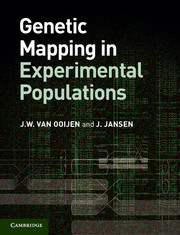Book contents
- Frontmatter
- Contents
- Preface
- 1 Introduction
- 2 Meiosis and genetic recombination
- 3 Estimation of recombination frequencies
- 4 Determination of linkage groups
- 5 Estimation of a genetic map
- 6 Criteria for the evaluation of maps
- 7 How to find the best map order
- 8 Outbreeding species
- 9 Mapping in practice
- Answers to exercises
- Index
Preface
Published online by Cambridge University Press: 05 August 2013
- Frontmatter
- Contents
- Preface
- 1 Introduction
- 2 Meiosis and genetic recombination
- 3 Estimation of recombination frequencies
- 4 Determination of linkage groups
- 5 Estimation of a genetic map
- 6 Criteria for the evaluation of maps
- 7 How to find the best map order
- 8 Outbreeding species
- 9 Mapping in practice
- Answers to exercises
- Index
Summary
Genetic linkage maps play an important role in many branches of biological research. The specific calculations involved in the construction of genetic maps ask for dedicated computer software. When using this software, the construction of genetic maps looks simple: just press a few buttons and you get a map. However, things are not as simple as they look. The various computations are based on a fair amount of theory from genetics, probability, statistics and optimization. We felt the need to explain this theory and write a special textbook dedicated to the construction of genetic maps. We think it is essential reading for those who want to construct reliable genetic maps.
Ever since the late 1980s, when the first RFLP projects started in Wageningen, we have been involved in linkage analysis with molecular genetic markers. By the mid-1990s, we started teaching short courses on the construction of genetic maps. Currently, our course covers 3 days of lectures and practicals. This book is a complete rewrite of our course reader. The book is aimed at the biologist with an interest in the construction of genetic maps. For a proper understanding, knowledge of genetics, probability and statistics at the undergraduate level is required.
- Type
- Chapter
- Information
- Genetic Mapping in Experimental Populations , pp. xi - xiiPublisher: Cambridge University PressPrint publication year: 2013



